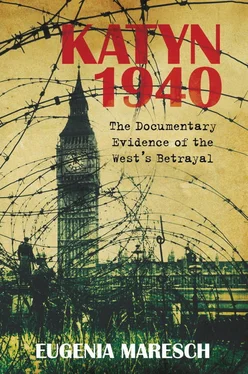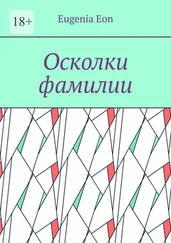Soon after one of those secret meetings, the NKVD started to compile a list of their captives with full particulars as well as addresses of their families, including those under the German occupation. By February 1940, Soprunenko had sent to his superior Beria detailed proposals on the ‘clearing out’ ( rozgruzky ) of PoW camps at Kozelsk and Starobelsk. He categorised the prisoners as those too ill (about 300), and those who were residents of the western region of Poland whose guilt could not be proven (about 500); these were to be sent home.
‘Special procedures’ were to be applied to those who were ‘hardened, irremediable enemies of Soviet power’: officers, police, landowners, lawyers, doctors, clergy and political activists. They were to suffer the ‘supreme punishment’ by shooting, without prior call to face the charges in any court. Stalin and others of the Politburo duly signed the order presented to them by Beria on 5th March 1940. The executions were to start in early April and last till May 1940. [4] Katyn. Dokumenty Zbrodni, Jeńcy nie wypowiedzianej wojny, 23 sierpień 1939 – 5 marca 1940 (Katyn, Documents of Crime, Prisoners of Undeclared War, 23 August 1939 – 5 March 1940), published jointly by Naczelna Dyrekcja Archiwów Państwowych (Directorate of The National Archives) in Warsaw and The National Archival Services of Russian Federation GARF ( Gosudarstvenny Arkhiv Rossiiskoi Federatsii ) and the Central Security Service Archives of the Russian Federation FSB RF ( Federalnaia Slusba Bezopasnosti Federatsii Rossiiskoi ) in Moscow. Editorial Committee under Aleksander Gieysztor and Rudolf Pikhoia, editorial work Wojciech Materski, Natalia Lebedeva and others. Warsaw 1995, Vol I, p.7-55, docs. 188, 216; Vol II docs. 87, 95; Vol III doc68; Vol IV docs. 197, 207, 208, 212, 221. Translated copies of the NKVD documents in four volumes, selected by the Russian and Polish historians between 1993 and 2005.
‘Operation Barbarossa’, the German invasion of the Soviet Union in June 1941, put an end to the volatile Nazi-Soviet Pact. For Poland it offered the opportunity to ally with the Soviets, albeit reluctantly and with British inducement. General Władysław Sikorski, [5] Władysław Sikorski (1881–1943). Polish General and statesman, took part in 1920 War of Independence against the Bolsheviks, Chief of General Staff, Premier and War Minister till 1925. Spent thirteen years in opposition. In 1939 escaped the German invasion via Rumania to France, formed a government in Paris, after its fall moved to GB together with armed forces, set up a coalition government in exile as its Prime Minister and Commander in chief. Died in plane crash off Gibraltar, 4 July 1943.
Prime Minister of the Polish government in exile and Commander-in-Chief of the Polish Armed Forces, with the Soviet Ambassador Ivan Maisky, signed a Pact in London on 30 July 1941. It was an uneasy alliance, but had one important military outcome, as it allowed the raising of a Polish Army on USSR territory made up of deported prisoners. The agreement stated that all Polish citizens held in the USSR were to be released on ‘amnesty’ – an irrational term as no war had been declared between Poland and the Soviet Union. The Polish government-in-exile did not argue, perhaps they considered it as a ‘face saving’ gesture to the Soviets. The pre-war border issue was provisionally settled by an ambiguous statement: ‘The Government of the Union of Soviet Republics recognizes that the Soviet-German Treaties of 1939 relative to territorial changes in Poland, have lost their validity.’
The release of men from prisons, PoW camps and forced labour GULags started in September. By October 1941, it was clear that the majority of army officers were missing and there was no news of them. After repeated enquiries, which remained unanswered, Molotov and Stalin finally maintained that ‘all officers were released.’ The Poles had good reason to disbelieve them but were powerless to do anything about it.
A Top Secret report of those detained by the NKVD [6] Katyn Dokumenty Zbrodni … Vol III document 217, Fedotov report 3 December 1941.
was prepared by Captain Pyotr Fedotov, head of 2ed Administration of the NKVD for his superior Soprunenko and handed to Stalin on the day he met with Sikorski and General Władysław Anders, [7] Władysław Anders (1892-1970), General, served as a young officer in the Tsarist army during the First World War, later joined the Polish Army and fought in 1920 War of Independence against the Russians. In 1939 commanded a cavalry brigade, wounded and taken prisoner by the Russians and held at Lubyanka prison in Moscow. Released after the Soviet-Polish Agreement of 14 August 1941. Commander of a newly formed Polish Army in USSR from thousands of Poles released from Russian imprisonment. Commander in Chief of 2 Polish Corps (under command of the British Eighth Army) who led the Poles to victory at the battle of Monte Cassino in Italy. After the Polish Forces were disbanded in 1946, remained in exile as a prominent leader of the ‘free’ Poles. Wrote memoirs, Bez Ostatniego Rozdziału (Without the Last Chapter) 1949.
Commander of the newly formed Polish Army in the USSR, on 3 December in Moscow. This most secret report indicated that the total number of prisoners of war captured by the Red Army was 130,242: some 42,400 were conscripted into the Red Army and a similar number, 42,492, were exchanged with Germany. Only 25,115 soldiers were released to join the Polish Army formation centres. 1,901 were rejected by the army or handed over to the German Embassy, some were invalided out, or counted as runaways, or were dead. Most importantly, Fedotov’s report included a reference to 15,131 men ‘disposed of in April-May 1940 by the 1st Special Department’, which surely indicates the officers of Kozelsk, Ostashkov and Starobelsk camps. Stalin avoided mentioning these during the Kremlin meeting. A much later document reveals that in March 1959, Aleksandr Shelepin, head of the KGB wrote a note for Nikita Khrushchev, 1st Secretary of the Communist Party and head of state, putting the figure at 14,552, which is generally accepted as a more probable number of those massacred from the three camps. Fedotov’s report brings the total – alive and dead – to 257,186. Again, by Western calculations, based on archival sources, about 250,000 is the more likely figure.
Absolute silence over the existence of these ‘missing’ prisoners baffled the British Military Mission in Moscow. Brigadier Colin McVean Gubbins, one-time member of the British Military Mission to Poland in 1939 and later head of the SOE (Special Operations Executive), was also concerned about the strength of the Polish forces, with the core of the military men missing or imprisoned. SOE’s aim was to foster resistance movements in Western Europe. Although the distance and geographical position of Poland made the task difficult, SOE did have a Polish Section, responsible for clandestine operations. They used the secure communication facilities of Oddział VI , the Special Operations Bureau of the Polish General Staff headed by Staff Lt Colonel Michał Protasewicz in London. It is through him that signals from the Home Army – AK ( Armia Krajowa ) were analysed, translated and distributed to various Departments, including the British.
Lieutenant General Mason MacFarlane’s Report
The British Cabinet Office already knew of the Polish plight through successive British Ambassadors, Sir Stafford Cripps (till December 1941) and later Sir Archibald Clark Kerr, as well as from No.30 Military Mission in Moscow, headed by Lieutenant General Noel Mason MacFarlane, [8] Frank Noel Mason MacFarlane (1889–1953) Lt Gen. RA, served in Africa and India, Staff Capt. WWI, Afghan War 1919, GSO1 in India 1922-5, Staff officer 1928–30 in India, Military Attaché Budapest 1931–5, Vienna, Berne then Berlin 1937–39, Head of Military Mission in Moscow 1941–2, Governor of Gibraltar 1942–44, Chief Commissioner of Allied Control Commission in Italy 1944, awarded Polonia Restituta 1st class, retired 1945, became an MP.
who despatched his reports regularly to Major General Francis Davidson, Director of Military Intelligence (DMI) at the War Office. One ‘personal for DMI’ report, dated 7 August 1941, expressed his fears about the situation and unwittingly indicated a stance for the British Government to take. His words were prophetic:
Читать дальше












